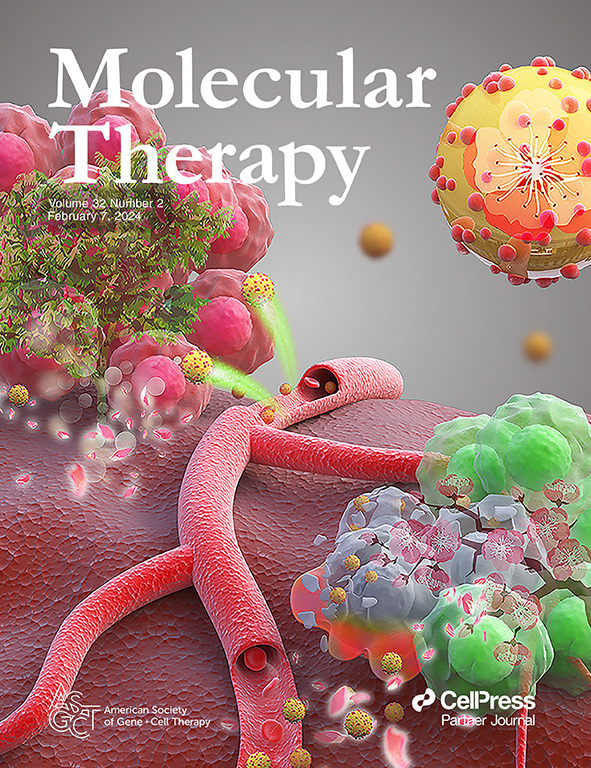依来克洛莫-铜联合靶向肿瘤干细胞的线粒体代谢,克服胰腺导管腺癌的化疗耐药。
IF 12
1区 医学
Q1 BIOTECHNOLOGY & APPLIED MICROBIOLOGY
引用次数: 0
摘要
胰腺导管腺癌(PDAC)是一种预后不良的侵袭性癌症,部分原因是癌症干细胞(CSCs)驱动进展和治疗耐药性。我们在富含csc的PDAC模型中探索了诱导铜增生的治疗潜力,铜增生是一种依赖铜的调节细胞死亡。通过人类和小鼠PDAC模型,我们评估了一种铜转运促进剂埃司克洛莫尔。单独使用埃司克洛莫尔效果最小;与氯化铜(CuCl2)结合,可显著且不可逆地降低CSC表型,而不影响未转化的细胞。在机制上,只有这两种组合才能使细胞内铜离子增加2-4倍,降低铁硫簇蛋白,并引起线粒体中脂肪酰化的DLAT积聚,从而引发铜增生,特别是在csc中。它还选择性地抑制PDAC细胞中依赖铜的抗氧化剂SOD1,损害氧化应激防御并使它们对铜诱导的死亡敏感。为了提高临床相关性,CuCl2被中空的介孔硫化铜纳米颗粒取代,释放铜离子。这些纳米颗粒无论是与埃司氯莫尔结合还是与埃司氯莫尔负载,都同样增加了铜水平并抑制了PDAC球体的形成。在体内,在具有侵袭性免疫能力的小鼠PDAC模型中,这种基于纳米颗粒的治疗显著改善了吉西他滨的反应。这些发现确定了纳米颗粒介导的铜体诱导,结合标准化疗,作为一种创新的csc靶向策略,可以改善PDAC的预后,为PDAC患者带来新的希望。本文章由计算机程序翻译,如有差异,请以英文原文为准。
Elesclomol-Copper combination synergistically targets mitochondrial metabolism in cancer stem cells to overcome chemoresistance in pancreatic ductal adenocarcinoma.
Pancreatic ductal adenocarcinoma (PDAC) is an aggressive cancer with poor prognosis, partly due to cancer stem cells (CSCs) that drive progression and treatment resistance. We explored the therapeutic potential of inducing cuproptosis, a copper-dependent regulated cell death, in CSC-enriched PDAC models. Using human and murine PDAC models, we evaluated elesclomol, a copper transport enhancer. Elesclomol alone had minimal effects; combined with copper chloride (CuCl2), it significantly and irreversibly reduced CSC phenotypes without affecting non-transformed cells. Mechanistically, only the combination raised intracellular copper ions 2-4-fold, decreased iron-sulfur cluster proteins, and caused fatty acylated DLAT accumulation in mitochondria, triggering cuproptosis, particularly in CSCs. It also selectively inhibited copper-dependent antioxidant SOD1 in PDAC cells, impairing oxidative stress defense and sensitizing them to copper-induced death. To enhance clinical relevance, CuCl2 was replaced with hollow mesoporous copper sulfide nanoparticles releasing copper ions. Either combined with or loaded with elesclomol, these nanoparticles similarly increased copper levels and inhibited PDAC spheroid formation. In vivo, in aggressive immunocompetent murine PDAC models, this nanoparticle-based treatment significantly improved gemcitabine response. These findings identify nanoparticle-mediated cuproptosis induction, combined with standard chemotherapy, as an innovative CSC-targeting strategy to improve PDAC outcomes, offering new hope for PDAC patients.
求助全文
通过发布文献求助,成功后即可免费获取论文全文。
去求助
来源期刊

Molecular Therapy
医学-生物工程与应用微生物
CiteScore
19.20
自引率
3.20%
发文量
357
审稿时长
3 months
期刊介绍:
Molecular Therapy is the leading journal for research in gene transfer, vector development, stem cell manipulation, and therapeutic interventions. It covers a broad spectrum of topics including genetic and acquired disease correction, vaccine development, pre-clinical validation, safety/efficacy studies, and clinical trials. With a focus on advancing genetics, medicine, and biotechnology, Molecular Therapy publishes peer-reviewed research, reviews, and commentaries to showcase the latest advancements in the field. With an impressive impact factor of 12.4 in 2022, it continues to attract top-tier contributions.
 求助内容:
求助内容: 应助结果提醒方式:
应助结果提醒方式:


